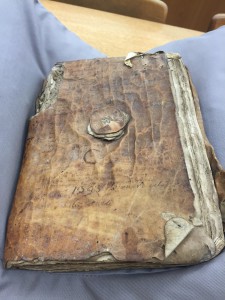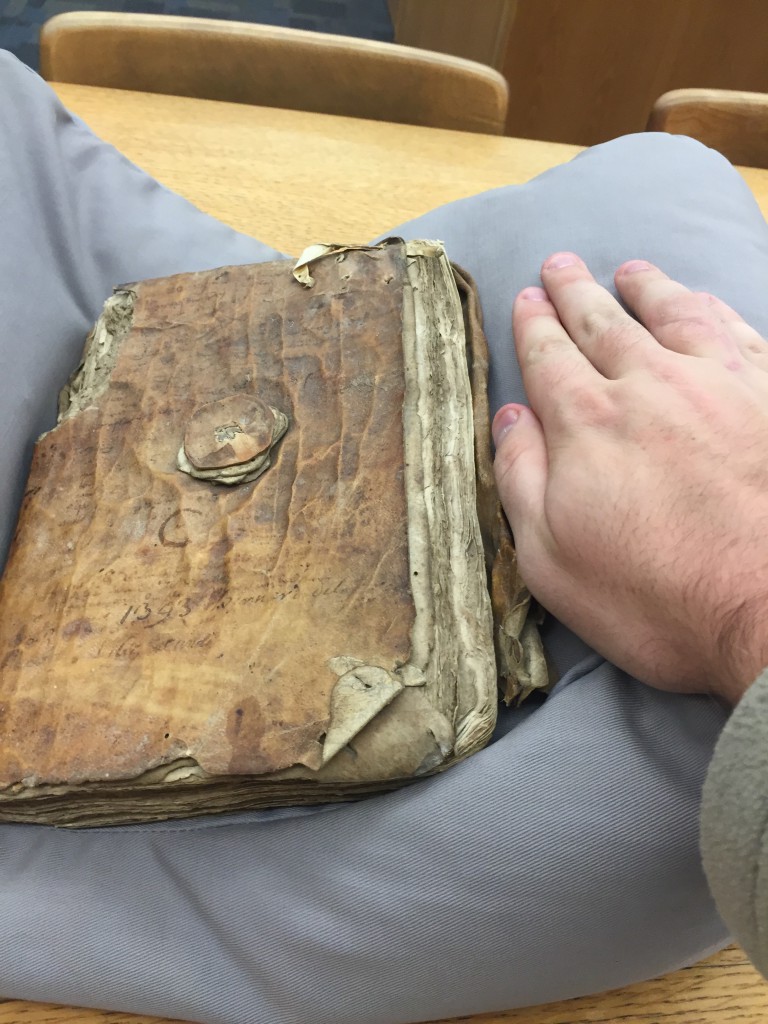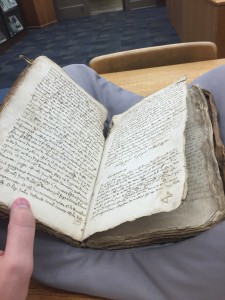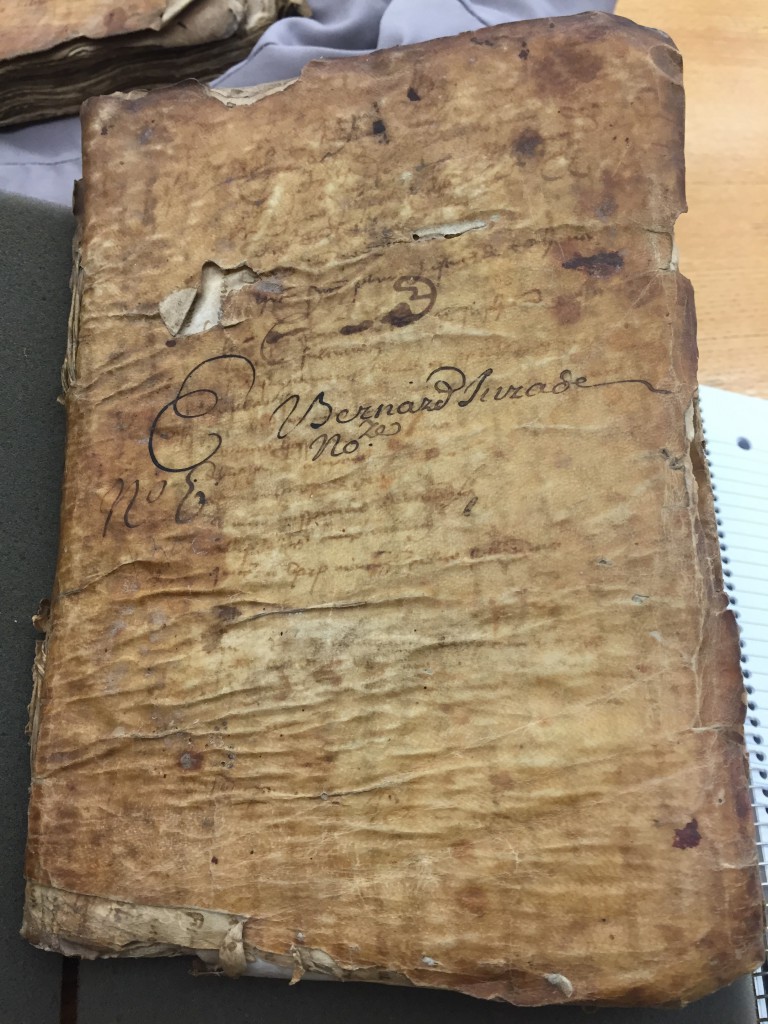Will Black, a student in Dr. Rabia Gregory's History of Christianity class, chose to write this personal reflection on his work with the fourteenth-century notarial registry in Special Collections. We're sharing his thoughts and images with his permission. – KH

On Thursday, October 29th, I walked into the Special Collections room in Ellis Library. I requested to see a notarial registry kept by Bernard de La Turade during the late fourteenth century. La Turade was a French notary, which meant he handled the wills, marriages contracts, sales, etc. for his town. It was a rather important position, considering it was the only form of recording that sort of information in the town during his day. People would come to La Turade for all different purposes, and it’s the surviving artifacts of common life that gives researchers a glimpse into the daily life of what France might have been like during the middle ages. It displayed prices of goods, legal documents, ages at which people were married, and all sorts of other little facts that expand upon the picture of daily life that ultimately end up completing the picture of history.
Upon first glance, the registry was unimpressive. It was roughly the size of my hand, slightly bigger. I’d estimate it was eight inches high, five inches across, and an inch and half thick. There were two volumes, the first of which had been aggressively chewed through by mice on the top left hand corner. Both books were a dark tan color, with the color and texture of the book resembling that of a pig ear treat one might give to their dog. According to Dr. Barabtarlo's lecture, the cover was likely animal skin for its protection and durability. Scrawled on the cover of Vol. 1 “1393”, the date of publishing by La Turade. According to a booklet on various binding methods put together by the special collections department at Yale University, the notary had a binding that was considered Gothic. The Gothic method closely resembles modern books of the day, with loose-leaf paper bound to a cover made of thicker parchment or skin. This method of binding was popular from the early fourteenth century until the end of the seventeenth century.

When I opened the first volume, it was in poor condition. Mice had eaten through the spine on the top left portion of the book, meaning the first 36 pages of the book had to be handled more delicately due to the lack of binding. There was plenty of water damage on the first pages of the book, but this faded about a third of a way through the notary. This book may have been face up in a damp or humid environment and years of water resting on its cover seeped through to the parchment. Before paper became easy to make, parchment was the choice for writing books. Parchment is made out of sheep’s skin and was chosen because it was super durable. During Medieval times, there was no way to have climate controlled rooms and traveling was harsh, so books were required to stand the test of the elements. On blank spaces between entries, one can see the watermarks from the making of the paper. This particular parchment maker had his frame set up so that lines supporting the paper were about two centimeters apart from each other.
By looking at the pages, it’s easy to tell that this book was used quite a bit. The fact that there are two volumes is telling in the fact that there were quite a bit of entries. The pages in both books were well smudged on the margins, resulting from the flipping of pages back and forth to find certain entries. There were also several pieces of scrap paper that had been added to pages via glue or other sticky substances. There were also many, many comments in the margins, entries crossed out, and various other edits to previous entries. This means that this book was used quite a bit over an extended period of time. Another indication that this book had extensive use comes from the fact that the ink recipe changes multiple times in the book. During my time examining the book, I asked Dr. Barabtarlo about the ink changes, and she said the ink recipe the author used a recipes alternating between being heavy in rust or lampblack.
More important than the book itself is the author and his uses for the book. Clearly, as a notary, Bernard de La Turade’s job was to simply be a record keeper. The local lord or other authority in the area likely employed him in the castle or other official building. According to the National Notary Association, notaries in the middle ages/medieval times could have had a role in the clergy. This would make sense considering a notary had to be of high moral character, but there’s no way to know if La Turade was a member or not. This becomes even more confusing as La Turade lived during the period when the clergy started to separate themselves and the role as notaries. Prior to his lifetime, notaries were exclusively clergymen, and after his lifetime it had become a secular business. La Turade was caught between these two eras. La Turade may or may not have been a clergyman, but we do know he was someone who was held in high moral regard. We can say though, that there’s a good chance La Turade got at least some part of his education from a person involved with the clergy in some way, considering they were the main teachers in the middle ages.

From what we know about social structures in Medieval France, where La Turade is from, he likely lived somewhere in the middle of the social ladder. La Turade could read, write, and do simple arithmetic, so he was obviously an educated man. This would save him from having to do hard labor in fields for the entirety of his life. La Turade also interacted with people in important positions, such as governors, lords, dukes, or even kings. His interactions with these people likely moved him up the ladder a couple of rungs. Even though La Turade did hold a position of importance within the town and he likely made a living better than other folk, he never would be confused with someone who would have been in the highest tax bracket. Books were still expensive during this time period, and were a labor to produce. Even though this book contained no writing or artistry when La Turade bought it, the parchment maker still had to skin a sheep, dry the skin, scrape it, and go through the whole tedious process of making usable parchment. The fact that La Turade was able to purchase this book says something about his wage, considering the price of books of the era.
The reality of this book is beautifully underwhelming. This was a simple notary written by a nondescript Frenchman in the late 1300’s. However, it gives insight into the daily life of the people of La Turade’s region. The documentation this book provides is the sole reason historians have jobs. The notarial registry also sheds light on the writing practices of the region and time period. Often these varied from place to place and era-to-era, and the book offers yet another link in the long chain of history. From a mice-bitten, water-damaged book, one infer as to how people of a completely era and culture survived.
– Will Black
